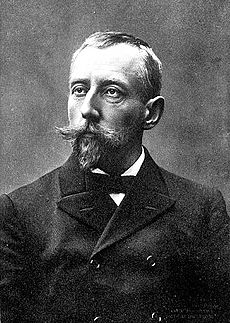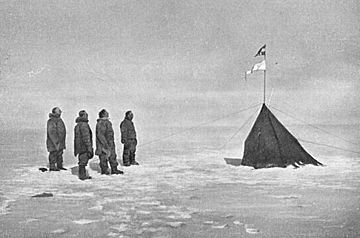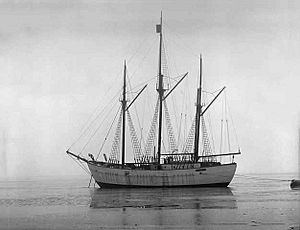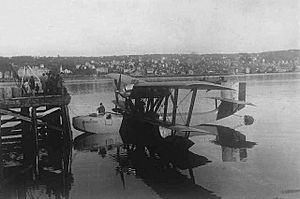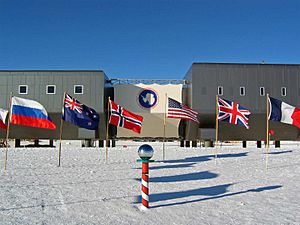Roald Amundsen facts for kids
Quick facts for kids
Roald Amundsen
|
|
|---|---|
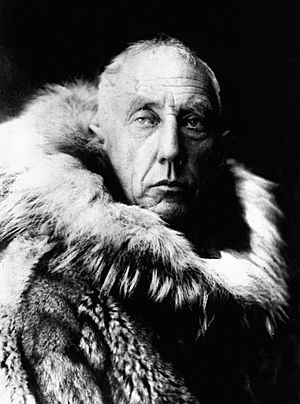
Amundsen c. 1923
|
|
| Born |
Roald Engelbregt Gravning Amundsen
16 July 1872 Borge, Østfold, Norway
|
| Disappeared | 18 June 1928 (aged 55) Barents Sea |
| Occupation | Explorer |
| Known for |
|
| Awards |
|
| Signature | |
Roald Engelbregt Gravning Amundsen (born July 16, 1872 – disappeared June 18, 1928) was a famous Norwegian explorer. He was known for his amazing journeys to the coldest parts of the world, the polar regions. He was a very important person during a time called the Heroic Age of Antarctic Exploration, when many brave explorers tried to reach the Earth's poles.
Amundsen was born in Borge, Østfold, Norway. He started his career as a polar explorer when he was a first mate on an expedition to Antarctica from 1897 to 1899. From 1903 to 1906, he led the first team to successfully travel through the Northwest Passage. This was a sea route connecting the Atlantic and Pacific oceans through the Arctic.
In 1909, Amundsen began planning a trip to the South Pole. He left Norway in June 1910 on his ship, the Fram. He reached Antarctica in January 1911. His team set up a camp and left supplies along the way. On December 14, 1911, Amundsen and his team of five became the first people to reach the South Pole.
After a failed attempt to reach the North Pole by ship in 1918, Amundsen decided to try by air. On May 12, 1926, Amundsen and 15 other men flew over the North Pole in an airship called the Norge. They were the first explorers confirmed to have reached the North Pole. Amundsen disappeared in June 1928 while on a rescue mission in the Arctic. He was trying to find another airship crew. His remains were never found.
Contents
Early Life and Dreams
Amundsen was born into a family of shipowners and captains in Borge, Østfold, Norway. He was the fourth son of Jens Amundsen and Hanna Sahlqvist. His mother wanted him to become a doctor, not a sailor. Roald promised her he would, and he studied medicine until she passed away when he was 21. After that, he quickly left university to follow his dream of a life at sea.
When he was 15 years old, Amundsen read exciting stories about Sir John Franklin's Arctic expeditions. Amundsen later wrote that these stories "shaped the whole course of my life." He was fascinated by the idea of exploring the unknown polar regions.
Amazing Polar Journeys
First Antarctic Winter
In 1897, when he was 25, Amundsen joined the Belgian Antarctic Expedition as the first mate. This expedition, led by Adrien de Gerlache, used a ship called the RV Belgica. It became the first expedition to spend a winter in Antarctica. The Belgica got stuck in the sea ice near Alexander Island. The crew had to survive a very harsh winter, and they were not well prepared for it.
The expedition's doctor, Frederick Cook, helped save the crew from scurvy. Scurvy is a serious illness caused by not getting enough vitamin C. Cook hunted animals and fed the crew fresh meat. Raw meat, especially from organs, contains enough vitamin C to prevent scurvy when citrus fruits are not available.
Conquering the Northwest Passage
In 1903, Amundsen led the first expedition to successfully sail through Canada's Northwest Passage. This passage connects the Atlantic and Pacific oceans. He chose a small fishing vessel, the Gjøa, with only six men. This small ship was flexible and could sail in shallow waters. It also had a small 13-horsepower diesel engine.
They sailed through Baffin Bay and the Parry Channel. They spent two winters at King William Island, in a place now called Gjoa Haven. During this time, Amundsen and his crew learned important survival skills from the local Netsilik Inuit people. These skills were very helpful for his later trips. For example, he learned to use sled dogs for travel and to wear animal skins instead of heavy wool clothes, which could get wet and cold.
After leaving Gjoa Haven, they continued west. On August 17, 1905, the ship finally cleared the Canadian Arctic Archipelago. They had to stop for another winter before reaching Nome, Alaska on the Pacific coast. Amundsen traveled 500 miles (800 km) overland to send a telegram on December 5, announcing his success.
Amundsen learned that Norway had become an independent country with a new king, Haakon VII. He sent the king a message saying that sailing the Northwest Passage was "a great achievement for Norway." The crew returned to Oslo in November 1906, after almost three and a half years away. The Gjøa ship was later returned to Norway in 1972. It is now displayed inside its own building at the Fram Museum in Oslo.
Race to the South Pole
Amundsen's next plan was to go to the North Pole. But in 1909, he heard that two Americans, Frederick Cook and Robert Peary, claimed to have already reached the North Pole. So, Amundsen secretly changed his plans and decided to go to Antarctica instead. He didn't tell everyone, which surprised Robert F. Scott, who was also planning a South Pole trip. Amundsen left Oslo on June 3, 1910, on the ship Fram. When he reached Madeira, he told his crew they were heading to Antarctica. He also sent a telegram to Scott, letting him know.
Six months later, on January 14, 1911, the expedition arrived at the Ross Ice Shelf in Antarctica. They set up their main camp, which Amundsen called Framheim. Amundsen chose to wear Inuit-style fur clothes instead of the heavy wool clothing used by other explorers.
Amundsen and his men used skis and dog sleds to travel. They set up supply depots at 80°, 81°, and 82° South, directly towards the Pole. Amundsen also planned to use some of his dogs for fresh meat for the remaining dogs and for the men. A small group tried to start the journey on September 8, but the weather was too cold. This caused an argument, and Amundsen sent some men to explore another area.
A second attempt began on October 19, with a team of five: Olav Bjaaland, Helmer Hanssen, Sverre Hassel, Oscar Wisting, and Amundsen. They took four sledges and 52 dogs. They used a new route along the Axel Heiberg Glacier. After a four-day climb, they reached the Polar Plateau on November 21. The team and 16 dogs arrived at the South Pole on December 14, 1911. This was a month before Scott's group. Amundsen named their South Pole camp Polheim. They left a small tent and a letter to show they had been there, in case they didn't make it back safely.
The team returned to Framheim on January 25, 1912, with 11 dogs still alive. They left Antarctica and traveled to Hobart, Australia. Amundsen announced his success to the world on March 7, 1912.
Amundsen's expedition was successful because he planned very carefully. He had good equipment, the right clothes, and understood how to work with dogs and skis. Unlike Scott's difficult journey, Amundsen's trip was smooth and successful.
North Polar Expeditions
The Northeast Passage by Ship
In 1918, Amundsen started a new expedition with a ship called Maud. This journey lasted until 1925. The Maud sailed carefully through the ice from west to east, through the Northeast Passage. Oscar Wisting and Helmer Hanssen, who had been with him to the South Pole, were also on this trip.
The main goal was to explore unknown parts of the Arctic Ocean. Amundsen wanted to freeze the Maud into the polar ice cap and let the ice carry the ship towards the North Pole, just like Fridtjof Nansen had done with the Fram. They tried this near Cape Chelyuskin. But the ice was too thick, and the ship got stuck. In September 1919, they got the ship free, but it froze again after 11 days.
During this time, Amundsen broke his arm and was attacked by polar bears. He couldn't do much outdoor work. He, Hanssen, Wisting, and two others tried to travel by dog sled to Nome, Alaska, which was over 1,000 kilometres (620 mi) away. But the ice in the Bering Strait wasn't frozen solid, so they couldn't cross.
After two winters stuck in the ice, Amundsen decided to go to Nome for repairs and supplies. Some crew members, including Hanssen, didn't return to the ship on time. Amundsen fired Hanssen for breaking his contract.
The Maud was stuck in the ice for a third winter. It finally broke free and sailed to Seattle in 1921 for repairs. Amundsen went back to Norway to sort out his money problems. He had adopted two young indigenous girls, Kakonita and Camilla, but when he went bankrupt two years later, he sent them to live with Camilla's father in Russia.
In June 1922, Amundsen returned to the Maud. He decided to change his plan from a ship expedition to an aerial one. He split his team: one part, led by him, would prepare to fly over the Pole in 1923. The other team on Maud, led by Wisting, would continue the original plan to drift over the North Pole in the ice. The ship drifted for three years but never reached the North Pole. It was eventually taken by Amundsen's creditors because of his debts.
Even though they didn't reach the North Pole, the scientific information gathered during the expedition was very valuable.
Flying to the North Pole

In 1923, Amundsen tried to fly over the North Pole with Oskar Omdal from the Norwegian Navy. They tried to fly from Wainwright, Alaska, to Spitsbergen. But their aircraft was damaged, and they had to stop the journey. To get more money, Amundsen went on a lecture tour across the United States in 1924.
In 1925, Amundsen, along with Lincoln Ellsworth, pilot Hjalmar Riiser-Larsen, and others, took two Dornier Do J flying boats, the N-24 and N-25. They reached 87° 44′ north, which was the farthest north anyone had flown at that time. The planes landed a few miles apart without radio contact, but the crews managed to find each other. The N-24 was damaged. Amundsen and his crew worked for over three weeks to clear an airstrip from the ice. They shoveled 600 tons of ice while eating very little food. Finally, all six crew members squeezed into the N-25. Riiser-Larsen managed to take off from the cracking ice, and they barely made it into the air. Everyone thought they were lost, so their return was a great triumph.
In 1926, Amundsen and 15 other men, including Ellsworth, Riiser-Larsen, and Oscar Wisting, made the first flight across the Arctic in the airship Norge. They left Spitsbergen on May 11, 1926, flew over the North Pole on May 12, and landed in Alaska the next day.
Disappearance and Legacy
Roald Amundsen disappeared on June 18, 1928, during a rescue mission in the Arctic. He was flying with Norwegian pilot Leif Dietrichson and French pilot René Guilbaud, along with three other Frenchmen. They were looking for missing members of another airship crew, led by Umberto Nobile, whose airship had crashed after returning from the North Pole. Amundsen's French Latham 47 flying boat was never seen again.
Later, parts of the plane, like a wing-float and a gasoline tank, were found near the Tromsø coast. It is believed that the plane crashed in the Barents Sea, and Amundsen and his crew died in the crash or soon after. The search for them was stopped in September 1928, and their bodies were never found.
In 2004 and 2009, the Royal Norwegian Navy used an unmanned submarine to search for the wreckage of Amundsen's plane. They searched a large area of the sea floor but did not find anything from the Amundsen flight.
Amundsen's Lasting Impact
Because of Amundsen's many important achievements in polar exploration, many places in both the Arctic and Antarctic are named after him. The Amundsen–Scott South Pole Station, a research station in Antarctica, is named in honor of Amundsen and his British rival, Robert Falcon Scott. Amundsen's name has even reached the moon! A crater on the moon, the Amundsen crater, is named after him. NASA is even thinking about using the rim of this crater as a possible landing spot for their Artemis 3 mission to the moon.
Amundsen's life and adventures have also been shown in movies. The 1969 film The Red Tent tells the story of the Nobile expedition and Amundsen's disappearance. In 1985, a TV show called The Last Place on Earth featured Sverre Anker Ousdal as Amundsen. More recently, a Norwegian film titled Amundsen, directed by Espen Sandberg, was released in 2019.
Images for kids
See also
 In Spanish: Roald Amundsen para niños
In Spanish: Roald Amundsen para niños



